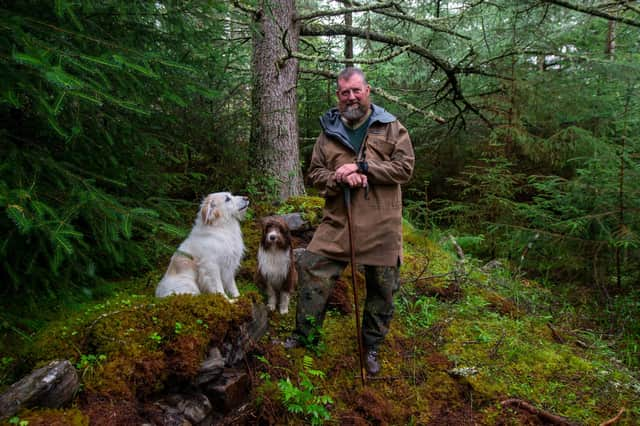Search for lost Highland township and its people torn apart by the Clearances


A major piece of work is underway to piece together the records of what happened at Inverlael Glen, near Ullapool, when at least 55 households were evicted from the land.
Little is known about those who were forced to leave with parish records of the population reportedly destroyed, such was the shame of the minister’s wife over what had happened.
Advertisement
Hide AdAdvertisement
Hide AdNow the Lost Inverlael/Finding Balblair project is underway to pinpoint the past life of the glen and its people.
Duncan Bain Mackenzie, a stalker who lives in Ullapool, has set up the project which is supported by Ullapool Museum, Historic Environment Scotland and Forestry and Land Scotland, which owns the land where the two townships of Inverlael and Balblair once stood.
His great, great grandparents were among those thrown off the land by George Steuart Mackenzie of Coul who embraced early 19th Century agricultural thinking that led to the mass displacement of people to make way for sheep farming.
Since he was a boy, Mr Mackenzie listened to stories from his grandfather about what happened to their family, who fled to the other side of Loch Broom following their eviction.
There over winter, they built a hovel near Clachan and lived off razor fish taken from a nearby river before moving to build a better house on the Lochside.
Mr Mackenzie said he believes the answers to what happened at Inveraul and Balblair lie overseas, with it believed some of those evicted families boarded a ship out of Ullapool to the New World, with Tasmania identified as a possible destination.
He said: “We are pretty much trying to rebuild the records here.
“It dawned on me that I have got no one left to get the history from. I am the end of the line and there is so much that is untold here
Advertisement
Hide AdAdvertisement
Hide Ad“What is important to me is that these people didn’t have a choice. They were told to go. This was not something that happened between the English and the Scottish.
“These were our own who launched these people into the west wind. We want to say ‘we are not forgetting you’.
“It is coming up to the 200th anniversary of the evictions and I felt it was time to do something.
“I think the history is pretty much overseas, I am pretty sure it is across te water.”
While it is believed a ship left Ullapool containing some of the tenants, it is not known where it went .
“What we really need is the name of a boat and find out how many people were on it and where it is going. At the moment, this part of the story remains an absolute mystery.”
Mr Mackenzie will work with archaeologists, archivists and the community to unravel the history of the glen, which he believes was a thriving place.
He added: “I feel what is left to today in the glen are the remnants of a very busy place.
Advertisement
Hide AdAdvertisement
Hide Ad“There is quite a bit of history to suggest this was a relatively well off place.”
Land taxes collected in 1809 for Invelaul were £506 but the figure for nearby Dundonald, a much bigger place, was £200, he said.
“We really want to find out what was going on there to make the land so valuable. I suspect it is a lot to do with the herring, netting salmon and perhaps trading in grain.”
As part of the project, archaeologists will be commissioned to piece together the everyday life in the glen.
There is evidence of a blacksmith’s on the site and, potentially, an inn once served the communiy with some indication ironworking may have been carried out here.
Over time, the glen was sold on between landlords.
He added: “They are there to make money. This place was an investment, a money making scheme. It is up to us to find out what was going on and to get into the nitty gritty of it all.”
Mr Mackenzie also called on people whose ancestors come from Balblair in Cromarty to contact the project, as he believes there is some confusion over the place where there family originated from.
The project has been supported with £68,000 from Historic Environment Scotland with further backing from Land and Forestry Scotland. Mr Mackenzie said he wanted to give special thanks to LFS archaeologist Matt Ritchie, who saw the potential of the project.
Advertisement
Hide AdAdvertisement
Hide AdProject co-ordinator Helen Avenell, of Ullapool Museum, appealed for anyone with information on ancestors from Inverlael and Balblair to contact the project.
She said: “Scraps of the social history of Inverlael have been preserved through oral tradition handed down through generations of local families.
“However much of the story of this cleared community and its evicted families has been lost, even though we know that Inverlael was a thriving community, at one time the largest community north of Dingwall.
“Alongside the archaeology programme, we are running a research project to get stories from families and relatives that will help in our understanding of the area.
“We also wish to hear from people who believed that their family were from Balblair (Cromarty). We believe that Balblair (Lochbroom) was a hugely populated area and many people may have the wrong Balblair when it comes to their own family history. If you believe your family were from Balblair but have found little information on the East Coast, then we at Ullapool Museum would really like to hear from you.”
The project can be contacted through its Facebook page @Lost Inverlael/Finding Balblair.
